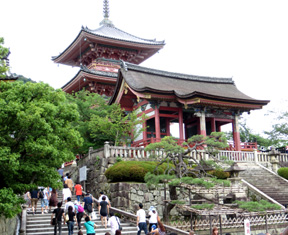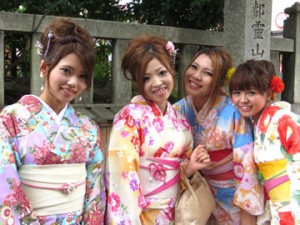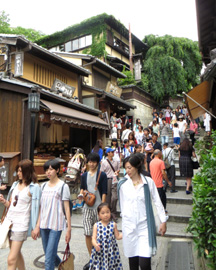Kyoto’s Buddhist temples and Shinto shrines are spread all over this fairly large city, and using the bus system is something visitors get used to doing quite quickly, unless they want to run up considerable taxi bills.
For us here at WoWasis, therefore, a half-day north to south walk along Kyoto’s eastern perimeter in the southern Higashiyama district was not only a relatively easy way to see temples, but it introduced us to some great neighborhoods, too. Obviously you can begin the walk from either direction, but we’ll describe it from south to north, beginning at the Kiyomzu-michi bus stop. You can arrive at this bus stop via bus lines 100, 202, 206, or 207. From there, go south for half a block, then walk up the hill heading east, bear right at the fork in the road, go up Chawan-zaka (Teapot Lane), a street with dozens of tourist trinket shops. Soon, you’ll see the pagoda of the Kiyomizu-dera temple. All of Kyoto’s historical temples charge an entrance fee, and in this case it’s 300 yen. We don’t think it’s worth 300 yen, nor is it worth 100 yen to go underground, visit “the womb” in darkness, and see a rock. With dozens of trinket shops inside, Kiyomizu Temple gets our vote for Kyoto’s biggest tourist ripoff. Its most interesting buildings are encountered before the ticket booth, so enjoy them, take some pictures, and leave with your hard-earned yen intact.
After visiting Kyomizu-dera, walk back down the hill for a few meters, then turn right at Sannen-zaka, which will begin yur tour of a number of beautiful streets with old houses that have been turned into interesting shops. Like much of Kyoto, there isn’t much in the way of street signs, but this walk is famous among Japanese locals and visitors, so just follow people, as they’re doing the same thing you are. Sannen-zaka will curve to the left, and shortly after the curve, turn right down a flight of steps to Ninen-zaka, another beautiful small street. On your walk, you’ll be tempted to go down other small streets, and it’s well worth doing so, as there are some beautiful old buildings there. On the weekends, dozens of girls in kimonos are touring these streets as well, adding to the traditional atmosphere that makes this walk a memorable one.
At the end of Ninen-zaka, zig zag left then right and continue north. A few meters down, make a left onto Ishibei-koji, a magnificent street made of tooled stone, then return to Ninen-zaka north, where you’ll pass the Kodai-ji shrine and enter Maruyama-koen park. After a drink break in the park, continue north to the Chion-in and Shoren-in temples, adjacent to each other. The Shoren-in temple was our favorite in Kyoto, with few crowds and a quiet atmosphere.
To end your walk, descend south on the busy Sanjo-dori street and you’ll arrive at the Higashiyama Sanjo bus stop, where you can pick up buses 5, 12, 46, 100, 201, 202, 203, or 206.



Leave a Reply